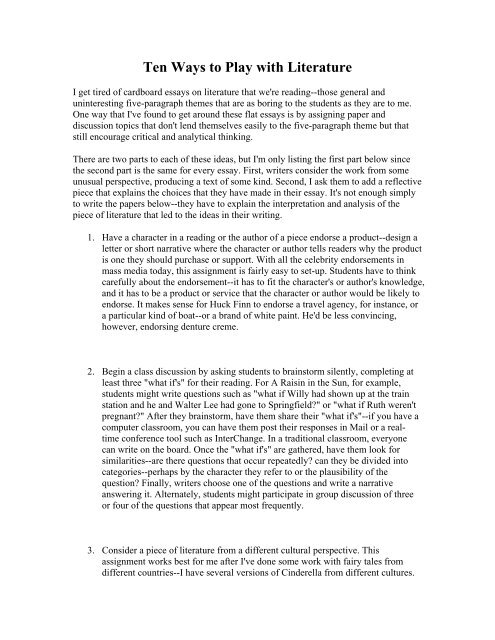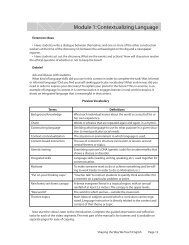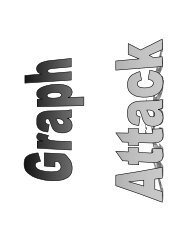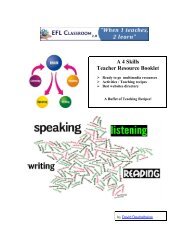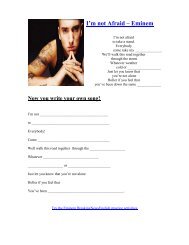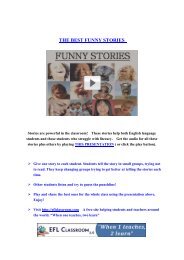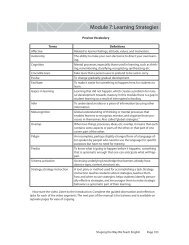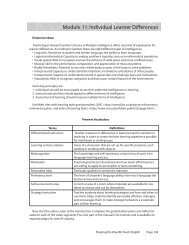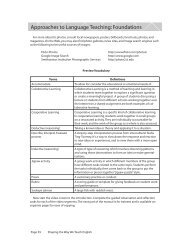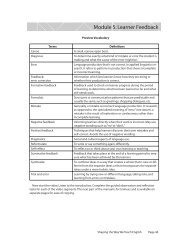Ten Audience Analysis Exercises - EFL Classroom 2.0
Ten Audience Analysis Exercises - EFL Classroom 2.0
Ten Audience Analysis Exercises - EFL Classroom 2.0
You also want an ePaper? Increase the reach of your titles
YUMPU automatically turns print PDFs into web optimized ePapers that Google loves.
<strong>Ten</strong> Ways to Play with Literature<br />
I get tired of cardboard essays on literature that we're reading--those general and<br />
uninteresting five-paragraph themes that are as boring to the students as they are to me.<br />
One way that I've found to get around these flat essays is by assigning paper and<br />
discussion topics that don't lend themselves easily to the five-paragraph theme but that<br />
still encourage critical and analytical thinking.<br />
There are two parts to each of these ideas, but I'm only listing the first part below since<br />
the second part is the same for every essay. First, writers consider the work from some<br />
unusual perspective, producing a text of some kind. Second, I ask them to add a reflective<br />
piece that explains the choices that they have made in their essay. It's not enough simply<br />
to write the papers below--they have to explain the interpretation and analysis of the<br />
piece of literature that led to the ideas in their writing.<br />
1. Have a character in a reading or the author of a piece endorse a product--design a<br />
letter or short narrative where the character or author tells readers why the product<br />
is one they should purchase or support. With all the celebrity endorsements in<br />
mass media today, this assignment is fairly easy to set-up. Students have to think<br />
carefully about the endorsement--it has to fit the character's or author's knowledge,<br />
and it has to be a product or service that the character or author would be likely to<br />
endorse. It makes sense for Huck Finn to endorse a travel agency, for instance, or<br />
a particular kind of boat--or a brand of white paint. He'd be less convincing,<br />
however, endorsing denture creme.<br />
2. Begin a class discussion by asking students to brainstorm silently, completing at<br />
least three "what if's" for their reading. For A Raisin in the Sun, for example,<br />
students might write questions such as "what if Willy had shown up at the train<br />
station and he and Walter Lee had gone to Springfield?" or "what if Ruth weren't<br />
pregnant?" After they brainstorm, have them share their "what if's"--if you have a<br />
computer classroom, you can have them post their responses in Mail or a realtime<br />
conference tool such as InterChange. In a traditional classroom, everyone<br />
can write on the board. Once the "what if's" are gathered, have them look for<br />
similarities--are there questions that occur repeatedly? can they be divided into<br />
categories--perhaps by the character they refer to or the plausibility of the<br />
question? Finally, writers choose one of the questions and write a narrative<br />
answering it. Alternately, students might participate in group discussion of three<br />
or four of the questions that appear most frequently.<br />
3. Consider a piece of literature from a different cultural perspective. This<br />
assignment works best for me after I've done some work with fairy tales from<br />
different countries--I have several versions of Cinderella from different cultures.


